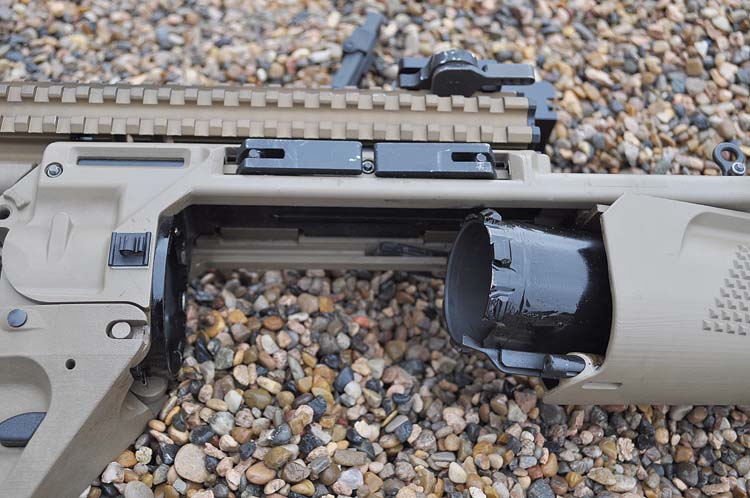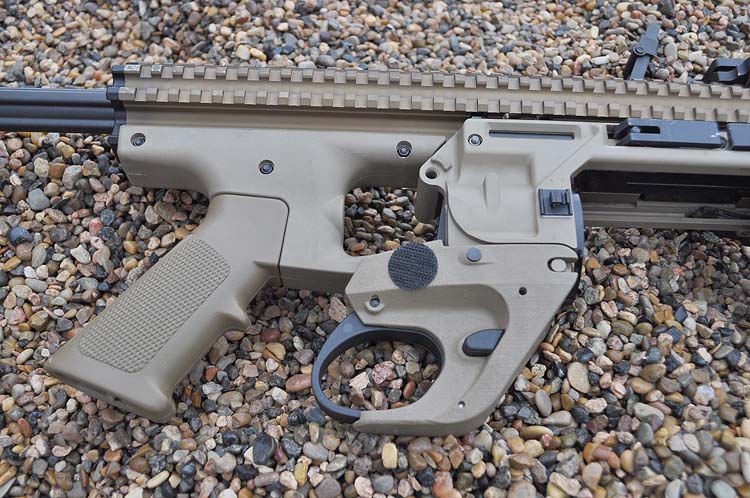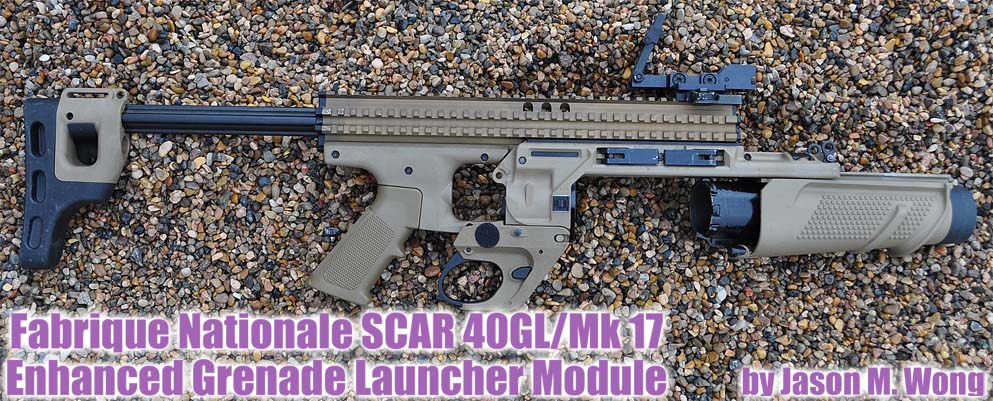The FN40GL 40mm grenade launcher, with barrel extended and canted to the right. The barrel is also capable to canting to the left for ease of loading from either side of the weapon.
As basic review, recall that the most recent variants of 40mm grenade systems are typically deemed “third generation” systems, following the design of the M79 40mm grenade launcher, the original first generation 40mm grenade launcher. Later second generation launchers are represented by the Colt M203, and the Heckler and Koch M69 launchers as systems that require mounting to the host weapon. The newest 40mm grenade launchers represent an entirely new system of weapons, representing the third generation of the 40mm grenade launcher. In general terms, third generation 40mm grenade launcher systems are defined as a multifunctional 40mm grenade launcher. That is, they are capable of functioning as a standalone unit or as part of an integrated rifle system. Third generation systems frequently feature the increased use of aluminum, composites, and polymers within the manufacturing process, and generally rely upon a side opening breech, rather than the M203’s slide forward breech mechanism. By opening to the side, the third generation systems are better capable of accepting 40mm rounds that are longer in length than the original M583 parachute flare round. This is a significant and important feature as increasing numbers of less lethal and medium velocity 40mm rounds enter the market. Finally, third generation systems all feature universal mounting solutions reliant upon Mil-Std 1913 Picatinny rails as a means of mounting the launcher to the host weapon. By presenting a universal mounting solution, third generation 40mm systems offer a unilateral cross-platform 40mm solution – that is, a single 40mm weapon system may be mounted on a host of primary weapons, without special tools in a quick and efficient manner. Mounting a third generation system to the host weapon typically requires the minimal use of common hand tools rather than relying upon specialized mounting hardware typically required to mount second generation 40mm systems to the host weapon. It should be no surprise that the Fabrique Nationale FN40GL system fits the definition of a third generation 40mm system nearly exactly.
The System
The FN40GL Enhanced Grenade Launcher is intended for integration with the Fabrique Nationale SCAR 16 and SCAR 17 rifles. Capable of firing all types of NATO standard 40x46mm low-velocity grenades, the FN40GL may be mounted under either rifle or may be configured as a stand-alone launcher.

When assembled on a Mk16/Mk17 host rifle, mounting is easily accomplished with a trigger adapter and dual locking clamp levers. The FN40GL easily mounts to the Picatinny rails at the 6 o’clock position on the host rifle. No special tools to mount or dismount the launcher from the host rifle are required as one merely flips the two mounting levers upward. The mounting system is as easily manipulated as any common Picatinny rail attachment. When mounted to the host rifle, the FN40GL is firmly mounted without any flex or movement, yet is easily removed quickly and without the use of tools.
Completely ambidextrous, the FN40GL utilizes a polymer receiver mated to an aluminum barrel for durability and light weight. Unlike other third generation 40mm systems, the 9.6-inch barrel swivels to the right or left for ease of loading and unloading from any firing position. This feature differentiates the FN40GL from other 40mm systems. While other systems allow the barrel to pivot to either the left or right, other 40mm systems force the user to choose one direction or the other. The FN40GL is currently the only 40mm system that allows the barrel to pivot in either direction at any time. While this may not seem significant, the ability to load the weapon from either the left or right allows left handed shooters to utilize a standard system without modification. More importantly, the design allows the shooter to load the weapon in any position – left or right – an important feature when loading from one side may prove difficult or impossible in the heat of battle.
The FN40GL may also be mounted to an alloy stand-alone stock assembly to allow individual use of the system. While the launcher is outfitted with Mil-Std 1913 Picatinny rails at the 12 o’clock position, the stand-alone stock assembly provides rails at the 3 o’clock, 6 o’clock, and 9 o’clock positions to allow the mounting of lights, lasers and other targeting devices. While this may not seem significant, recall than 40mm systems are being used in increasing numbers in a less lethal role. The ability to mount a forward grip, red dot sight, and laser aiming modules on the system may prove valuable on the battlefield, while the ability to mount ultra-bright LED lights and eye safe laser dazzlers may be more appropriate for use in situations involving civil disobedience.
Fabrique Nationale offers the FN40GL with a traditional folding leaf sight as standard sights. The application of optional after-market grenade launching sights or laser aiming modules is easily mounted to the system via the built in Mil-Std 1913 Picatinny rails.
At the Range
The FN40GL is a manually operated, single shot grenade launcher. Loading is easily accomplished by loading a 40mm grenade within the chamber of the weapon and closing the breech. The breech is a multiple lug rotating design. Unloading is easily accomplished by opening the breech via a lever on the left side of the weapon and removing the live round. The lever to open the breach is intuitive for right handed shooters, and is located in approximately the same location as the legacy M203 system. As the system opens to the left and right, an ambidextrous opening lever would be innovative, yet mechanically difficult to achieve with the current design.
The trigger of the system is unusually large and placed low on the weapon system. While the system was fired using the stand alone stock, it appears that the placement of the FN40GL trigger may allow the operator to keep the index (trigger) finger on the trigger of the host weapon, while using the shooter’s middle finger to fire the FN40GL. Regardless of finger placement, the FN40GL features a double action only trigger system that proved long and heavy. While firing the system was under ideal conditions, one must recall that most users will be firing the system under duress, whether a civil disturbance using less-lethal rounds, or on the battle field, firing high explosive rounds. The stress likely faced when firing the system necessarily requires a double action trigger as a means of preventing fratricide and unintended discharges of the weapon. When firing high explosive, one can never be too careful.
Accuracy of the system using the FN designed leaf sight was reasonable and targets at 250 meters were easily engaged within the kill radius of an M433 HE round. Presumably, accuracy would be better when used in conjunction with electronic or laser sighting systems. Muzzle velocity was approximately 250 feet per second.
Conclusion
The FN40GL is a highly capable third generation 40mm system. While the double action only trigger pull is not ideal, the long and heavy trigger pull is likely to prevent accidental discharges in high stress situations. It can be differentiated from others in the market in that the FN40GL is currently the only 40mm system that allows the barrel to pivot in either direction during the loading sequence. The system appears to be currently adaptable only to the FN SCAR 16 and SCAR 17, giving limited use on rifles outside of the FN family. Although tested with a standard leaf sight, accuracy of the system would presumably benefit with the addition of an aftermarket laser range finder, laser designator, or sighting system. Wide use of Mil-Std 1913 Picatinny rails allow the mounting of nearly any aftermarket sighting system. Additional information may be found online at www.fnhusa.com.

| This article first appeared in Small Arms Review V14N9 (June 2011) |











